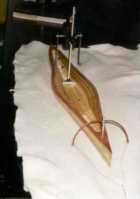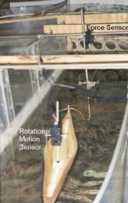 Detail of the canoe model Model built by Grasse River Boatworks, Canton, NY |
 Brendan & his canoe |
 The model in the SLU Geology flume, showing location of the force sensors |
The Effect Of Water Depth And Trim Angle
On Efficiency In Marathon Racing Canoes
Brendan P. Hogan '00
 Detail of the canoe model Model built by Grasse River Boatworks, Canton, NY |
 Brendan & his canoe |
 The model in the SLU Geology flume, showing location of the force sensors |
Abstract:
In the sport of marathon canoe racing, technological developments are used to ensure that competitors have the greatest chance for success. Typical races are up to fifteen miles and two hours in length and for that reason even small improvements in efficiency will have a significant effect on performance. One proposed improvement is to shift the center of gravity of the boat forward when the boat is in shallow water. The idea is that having the canoe trimmed bow down (the front end lower than the back end) is more efficient when traveling through shallow water.
The purpose of my project is to access the validity of that claim. I will be using a one-sixth scale model of a racing canoe and simulating the effect of paddling through still water by holding the model in place while a current of water flows past it. By measuring the drag of the model while it sits at a range of different trim angles, I can determine how the weight should be positioned in the canoe for a given depth. By repeating that procedure at a range of different depths I will be able to determine whether moving the weight forward in a canoe does have the desired improvement in efficiency when traveling in shallow water.
My results to date indicate that there is a surprisingly significant change in efficiency of the canoe for even small changes of the trim angle.
For more information, contact Dr. Brian Watson:
|
|
||
| © | St. Lawrence University | Department of Physics |
| Revised: 25 Jun 03 | Canton, NY 13617 |